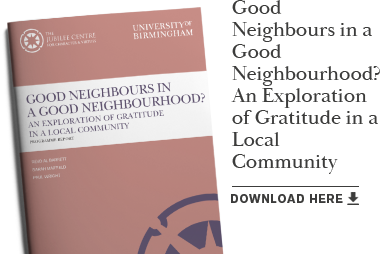Project Overview
The Good Neighbours in a Good Neighbourhood? project sought to discover and nurture a culture of gratitude within a community on an outer estate in East Birmingham. The project explored what people in the community were grateful for across different domains of gratitude, for example ‘places’. The project employed a variety of creative interventions with groups of different ages to encourage and further explore gratitude and its role within the community. This report provides an overview of the project and the approach adopted.

Summary of Key Findings
Participants were asked what they were thankful for, across different gratitude domains: ‘Me’; ‘People’, ‘Stuff’, and; ‘Places’. Responses highlighted:
- that people and relationships infused almost everything people were thankful for (even in the ‘stuff’ and ‘places’ domains); and
- that people tended to be more readily thankful for things that were more immediate in time and space.
The report also details a variety of creative ‘interventions’ with groups of different ages, to encourage and further explore gratitude. Evaluations of these activities from both participants and practitioners within the wider community highlighted:
- that organisations and agencies seeking to engage in ‘community regeneration’ do well to listen attentively to the things local people are thankful for, as well as what they might see as ‘problems’ (this might be articulated as an ‘asset-based community development’ approach);
- that generous time and intentional encouragement is often needed to help people express what they are thankful for, beyond the immediate: things from the past, things further away from ‘home’, gifts buried ‘deep within’;
- that asking ‘the gratitude question’ regularly, without too much formality, can move beyond initial strangeness to help people towards a noticeable positive difference in their outlook, often worked out in practical actions; and
- that creating inclusive environments that invite regular giving and receiving, such as a community lunch where people feel able to bring-and-share, can make a noticeable positive difference within a neighbourhood, a ‘hub of community’, going beyond the impact on individual participants.
